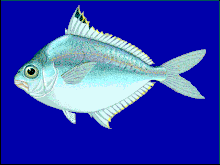Leiognathidae
| Leiognathidae | |
|---|---|

| |
| Eubleekeria splendens | |
| Scientific classification | |
| Domain: | Eukaryota |
| Kingdom: | Animalia |
| Phylum: | Chordata |
| Class: | Actinopterygii |
| Order: | Perciformes |
| Suborder: | Percoidei |
| Family: | Leiognathidae T. N. Gill,1893[2] |
| Type species | |
| Leiognathus argenteus Lacépède, 1802[3]
| |
| Genera | |
|
see text | |
Leiognathidae,theponyfishes,slipmouthsorslimys / slimies,are a small family of fishes in the orderPerciformes.[4]They inhabit marine and brackish waters in the Indian and West Pacific Oceans. They can be used in the preparation ofbagoong.
Characteristics
[edit]Ponyfishes are small and laterally compressed in shape, with a bland, silvery colouration. They are distinguished by highly extensible mouths, and the presence of a mechanism for locking the spines in thedorsalandanal fins.They also possess a highly integrated light organ in their throats that houses symbiotic bioluminescent bacteria that project light through the animal's underside.[5][6][7]Typically, the harbored bacterium is onlyPhotobacterium leiognathi,but in the two ponyfish speciesPhotopectoralis panayensisandPhotopectoralis bindus,Photobacterium mandapamensisis also present.[8]Two of the most widely studied uses for luminescence in ponyfish are camouflage by ventral counterillumination[9][10]and species-specific sexual dimorphism.[6][7][11][12] The light organ systems of ponyfishes are highly variable across species and often between sexes.[11][12]
Taxonomy
[edit]Leiognathidae is classified within thesuborderPercoideiby the 5th edition ofFishes of the World,but they are placed in an unnamedcladewhich sits outside thesuperfamilyPercoidea.This clade contains 7 families which appear to have some relationship toAcanthuroidei,Monodactylidae,andPriacanthidae.[13]Other authorities have placed the family in the orderChaetodontiformesalongside the familyChaetodontidae.[14]
Timeline of genera
[edit]
Genera
[edit]The following genera are classified within the Leiognathidae:[4][3]
- AurigequulaFowler,1918
- DeveximentumFowler,1904 (previously as replacement nameSecutorGistel,1848)
- EquulitesFowler, 1904
- EubleekeriaFowler, 1904
- GazzaRüppell,1835
- KarallaChakrabarty&Sparks,2008
- LeiognathusLacepède,1802
- NuchequulaWhitley,1932
- PhotolateralisSparks & Chakrabarty, 2015[15]
- PhotopectoralisSparks,Dunlap&Smith,2005
References
[edit]- ^Sepkoski, J. (2002)."A compendium of fossil marine animal genera".Bulletins of American Paleontology.364:560. Archived fromthe originalon 2011-07-23.
- ^Richard van der Laan; William N. Eschmeyer & Ronald Fricke (2014)."Family-group names of Recent fishes".Zootaxa.3882(2): 001–230.doi:10.11646/zootaxa.3882.1.1.PMID25543675.
- ^abEschmeyer, William N.;Fricke, Ron & van der Laan, Richard (eds.)."Genera in the family Leiognathidae".Catalog of Fishes.California Academy of Sciences.Retrieved18 November2020.
- ^abFroese, Rainer, and Daniel Pauly, eds. (2015)."Leiognathidae"inFishBase.February 2015 version.
- ^Johnson, G.D. & Gill, A.C. (1998). Paxton, J.R. & Eschmeyer, W.N. (eds.).Encyclopedia of Fishes.San Diego: Academic Press. p. 186.ISBN978-0-12-547665-2.
- ^abHaneda, Y.; Tsuji, F.I. (1976). "Luminescent systems of pony fishes".Journal of Morphology.150(2): 539–552.doi:10.1002/jmor.1976.150.2.539.S2CID91711575.
- ^abMcFall-Ngai, M.J.; Dunlap, P.V. (1984). "External and internal sexual dimorphism in leiognathid fishes: Morphological evidence for sex-specific bioluminescent signaling".Journal of Morphology.182(1): 71–83.doi:10.1002/jmor.1051820105.ISSN1097-4687.PMID6492170.S2CID23956409.
- ^Kaeding, A.J.; Ast, J.C.; Pearce, M.M.; Urbanczyk, H.; Kimura, S.; Endo, H.; Nakamura, M.; Dunlap, P.V. (2007)."Phylogenetic Diversity and Cosymbiosis in the Bioluminescent Symbioses of" Photobacterium mandapamensis "".Applied and Environmental Microbiology.73(10): 3173–3182.Bibcode:2007ApEnM..73.3173K.doi:10.1128/AEM.02212-06.ISSN0099-2240.PMC1907103.PMID17369329.
- ^Hastings, J.W. (1971). "Light to Hide by: Ventral Luminescence to Camouflage the Silhouette".Science.173(4001): 1016–1017.Bibcode:1971Sci...173.1016W.doi:10.1126/science.173.4001.1016.ISSN0036-8075.PMID17796582.S2CID5680392.
- ^McFall-Ngai, M.J.; Morin, J.G. (1991)."Camouflage by Disruptive Illumination in Leiognathids, a Family of Shallow-Water, Bioluminescent Fishes".Journal of Experimental Biology.156(1): 119–137.doi:10.1242/jeb.156.1.119.ISSN0022-0949.
- ^abSparks, J.S.; Dunlap, P.V.; Smith, W.L. (2005)."Evolution and diversification of a sexually dimorphic luminescent system in ponyfishes (Teleostei: Leiognathidae), including diagnoses for two new genera"(PDF).Cladistics.21(4): 305–327.doi:10.1111/j.1096-0031.2005.00067.x.hdl:2027.42/72092.ISSN1096-0031.PMID34892969.S2CID53063530.
- ^abChakrabarty, P.; Davis, M.P.; Smith, W.L.; Berquist, R.; Gledhill, K.M.; Frank, L.R.; Sparks, J.S. (2011). "Evolution of the light organ system in ponyfishes (Teleostei: Leiognathidae)".Journal of Morphology.272(6): 704–721.doi:10.1002/jmor.10941.ISSN1097-4687.PMID21433053.S2CID9331522.
- ^J. S. Nelson; T. C. Grande; M. V. H. Wilson (2016).Fishes of the World(5th ed.). Wiley. p. 453.ISBN978-1-118-34233-6.
- ^R. Betancur-Rodriguez; E. Wiley; N. Bailly; A. Acero; M. Miya; G. Lecointre; G. Ortí (2017)."Phylogenetic Classification of Bony Fishes – Version 4".BMC Evolutionary Biology.17(162): 162.Bibcode:2017BMCEE..17..162B.doi:10.1186/s12862-017-0958-3.PMC5501477.PMID28683774.
- ^Sparks, J.S.; Chakrabarty, P. (2015). "Description of a new genus of ponyfishes (Teleostei: Leiognathidae), with a review of the current generic-level composition of the family".Zootaxa.3947(2): 181–190.doi:10.11646/zootaxa.3947.2.2.PMID25947728.
